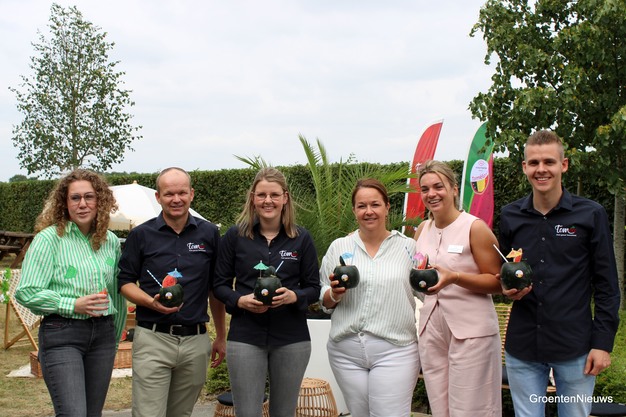Right on schedule, watermelons from VW Maxburg's greenhouses have hit the shelves at three supermarket chains in Belgium this week. This year, production has been scaled up to 2.2 hectares, expected to yield around 300,000 watermelons. To celebrate the first harvest, Tomeco and Coöperatie Hoogstraten, which markets the Tomélon, invited the press to the greenhouse.
 Coöperatie Hoogstraten and Tomeco organised a celebration of the new harvest of the Tomélon at VW Maxburg in Hoogstraten.
Coöperatie Hoogstraten and Tomeco organised a celebration of the new harvest of the Tomélon at VW Maxburg in Hoogstraten.
"I'm not very good at this," laughs cultivation specialist Lynn Vermeiren as she slices a few mini watermelons under the watchful eye of the press on Tuesday morning. Yet together with her team, she has clearly mastered the cultivation process. A little later, neatly sliced watermelon is served to all attendees. In the afternoon, Lynn will do it all again, this time for a group of influencers invited to get acquainted with the Tomélon. They, too, will definitely want a taste.
 Lynn Vermeiren cuts the Tomélon. Jana Jochems of Coöperatie Hoogstraten looks on.
Lynn Vermeiren cuts the Tomélon. Jana Jochems of Coöperatie Hoogstraten looks on.
With the cultivation of mini watermelons, Tomeco has tapped into a visually appealing and media-friendly diversification. It's a distinctive vertical crop grown on gutters, which also makes it a sustainable one, as Franky van Looveren of Tomeco explains. Compared to watermelon cultivation abroad, the Flemish greenhouse requires very little water. "We reuse our water and only need 15 litres per kilo of watermelon," he says.

The fruit weight of the harvested Tomélon is between 600 grams and 1.7 kilograms.
The seeds were sown in early April and planted in the greenhouse a month later, following an extended tomato cultivation. The 10-hectare site also includes cucumber crops grown alongside the watermelons. Tomatoes are grown in another section of the greenhouse.

Now you understand that cutting the Tomélon with so many onlookers was equally exciting for grower Lynn.
Learning about cultivation
The Tomélon project officially launched in 2020, followed by the first trial crop in 2021. At that time, the watermelons were sometimes still grown among tomatoes or cucumbers, using the high-wire method.
This changed last year when cultivation moved to another Tomeco site. There, the crop performed well on lower gutters and proved more labour-efficient, site manager Mitch Vermeiren explains. So this year in Hoogstraten, they chose not to grow the plants very high anymore. A few are still grown on high wires, as a test to see if there is any difference in labour and yield.

Except for a few rows, there is no longer any high-wire growing of the mini watermelon. The crop is guided back down with a brace.
Quickly on the local supermarket shelf
It's always striking to see uniform green fruits, virtually seedless and weighing up to 1.7 kilograms, hanging neatly from tall plants. Each fruit is marked with a coloured peg, allowing growers to track exactly when to harvest for optimal quality and flavour.
To illustrate this, Franky measures the brix level of a freshly harvested fruit in the greenhouse: 11, a very solid score. "But aside from having a brix between 9 and 11, the Tomélon also has an excellent bite," he adds. "That's because we harvest locally and can get the fruit onto shelves quickly."
 Franky van Looveren briefly measures the brix.
Franky van Looveren briefly measures the brix.
The Tomélon weighs between 600 grams and 1.7 kilograms. After harvesting, the fruit is distributed via Coöperatie Hoogstraten to Aldi, Jumbo, and Carrefour. There, consumers have come to recognise and seek out the fruit. Thanks to strong demand, the cultivation area has gradually increased in recent years.
 Coloured pegs are used to keep track of the week of setting, so growers also know exactly when to harvest the fruit.
Coloured pegs are used to keep track of the week of setting, so growers also know exactly when to harvest the fruit.
Growing in greenhouses offers better control over conditions, though it remains a natural product. Now in their fourth year of cultivating mini watermelons, Tomeco growers have built up valuable experience. "As with other crops, we use degree days to predict when we'll enter the production phase," Franky says. "Melons naturally have a wave-like production pattern, which we plan around—sometimes by aligning retail campaigns with peak harvest times."
Meanwhile, more Tomélon slices are passed around. Lynn shares a practical tip: "Keep the Tomélon in the fridge, and take it out about an hour before eating. That's when it's at its tastiest."

The Tomeco growers were often allowed to appear in photos or in front of a camera on Tuesday.
 Natalie Snijers of Coöperatie Hoogstraten hands out Tomélon segments.
Natalie Snijers of Coöperatie Hoogstraten hands out Tomélon segments.
For more information:
Coöperatie Hoogstraten
[email protected]
www.hoogstraten.eu
